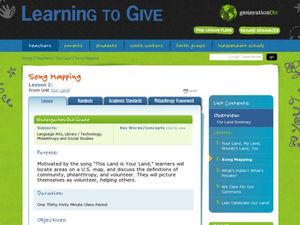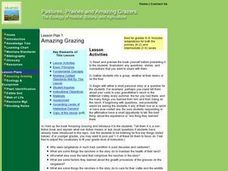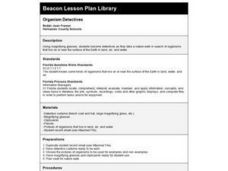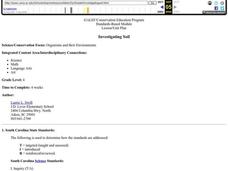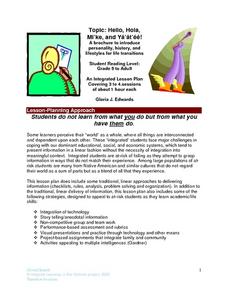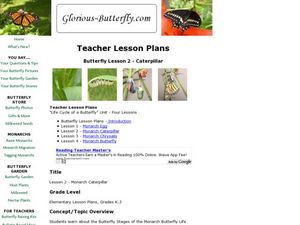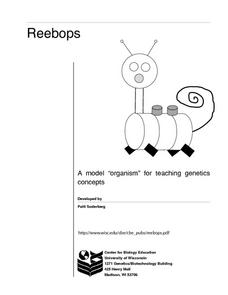Curated OER
Committing to Nonviolence: A Lesson from Viva La Causa
Students examine the social change movements of the American 20th century. In this nonviolence lesson, students research the work of Mahatma Gandhi, Martin Luther King, Jr., and Caesar Chavez. Students compare and contrast the social...
Curated OER
Song Mapping
Learners explore locations on the United States map. In this map skills activity, students recite the song This Land Is Your Land and locate various places listed in the song on the map.
Curated OER
Amazing Grazing
Students discuss their experiences on a ranch. As a class, they tell the best part of their experiences or one thing they gathered from being on the ranch. They listen to the story and identify five items to focus on in the reading and...
Curated OER
Organism Detectives
First graders take a nature walk and search for organisms. They use magnifying glasses to see things that live on or near the surface of the Earth in land, air, and water.
Curated OER
We are all Responsible
Students desribe the interdependence between humans and nature and positive behavior with regards to natural resources. They demonstrate respectful attitudes and behaviors with regards to the environment. Students gain knowledge of...
Curated OER
Investigating Soil
Fourth graders swap local soil samples with another school and examine the differences. They research soil properties, identify organisms that live in soil, create and maintain a biome of soil decomposition and design a poster to present...
Curated OER
Hello And Hola
Fifth graders investigate the concept of change and how it can effect the lives of different people. They use a real experience or hypothetical one to create a brochure on Microsoft Publisher to help someone to make the transition...
California Academy of Science
Discovering Rainforest Locations
How many rainforests are there, where are they, and do global factors effect their locations? These are great questions that have great answers. Children in grades four through eight use several different maps to determine why...
Curated OER
Save a Reef!
Design a public information campaign to improve understanding of the coral reef crisis. Read about and discuss the biology and threats to the coral reef. The class creates a public information program about the problems facing the coral...
Curated OER
Owls: Top of a Food Chain
Although written for middle schoolers, there is no reason that a 3rd, 4th, or 5th grader could not also learn about food chains through the dissection of owl pellets. After you introduce the topic, learners complete an owl research...
Curated OER
Teaching Kids about the Environment
Fifth graders identify the species of plants and animals found in an environment. They compare these findings to plant and animal species found in an unlike environment. Students acquire and compare soil samples from the two sites chosen.
Curated OER
Butterfly Lesson 2 - Monarch Caterpillar
Learners study the Monarch Butterfly life cycle. In this Monarch Butterfly instructional activity, students examine what happens prior to a caterpillar hatching, how often it sheds its skin, and what the caterpillar goes through when it...
Curated OER
Monarch Chrysalis
Students examine the last stage of the monarch butterfly. In this life cycles lesson, students read the book The Very Hungry Caterpillar and study photos of the monarch life cycle. Students illustrate the third stage of the monarch...
Curated OER
Forest Ecosystem
Students become familiar with the temperate rainforest. In this forest ecosystem lesson, students identify the producers, consumers and decomposers in the forest ecosystem. Students sort cards and identify the trophic level of the...
Curated OER
Email Riddles
Students compose riddles that are shared in a chat session conducted on their local school network. Students create clues that describe a specific animal or object. They watch as their words are typed onto the chat screen and sent to the...
Curated OER
Venus Flytrap
Students study the Venus Flytrap including its habitat and how it eats. In this ecology lesson students complete several experiments using a Venus Flytrap to see how it reacts to various conditions.
Curated OER
Happy Habitats
Students explore different habitats. In this habitat lesson plan, students investigate four different habitats through participating in a WebQuest. Students create an animal web using Kidspiration or a video documentary upon completing...
Curated OER
Web of Life - Role-Playing
Students role-play how organisms adapt to their environment. They play 20 questions with plant and animal habitats. They create a web of life to demonstrate how each plant and animal relies on the other for survival.
Curated OER
Ecosystem Vocabulary
In this ecosystem activity, students read descriptions and match the appropriate vocabulary term using ecosystem, habitat, community, and population. Students identify ten vocabulary terms.
Curated OER
Cycles of Life in an Urban Habitat: Changes in Biodiversity
Second graders compare and contrast animate and inanimate objects. For this environmental science lesson, 2nd graders create simple food webs. They observe their environment and create a collage about it.
Curated OER
Habitat Sunprints
Young scholars recognize various habitats and where they are found. In this habitat sunprints lesson, students observe the contents of habitats and record what the sunprint might represent. Young scholars use blueprint paper and small...
Loudoun County Public Schools
Figurative Language Packet
A definitive resource for your figurative language unit includes several worksheets and activities to reinforce writing skills. It addresses poetic elements such as simile and metaphor, personification, hyperbole, and idioms, and...
Curated OER
Plant Parts and their Function
Discover why plants are important to our world. View plant parts and categorize them as stems or buds. Students do a cut and paste of pictures of plants into correct categories. Students also plant a carrot top,and record the growth and...
Curated OER
Reebops a Model "Organism" for Teaching Genetics Concepts
Reebops are cute, marshmallow-based creatures that can be used to teach inheritance. Beginning biologists draw strips of paper that represent chromosomes from two envelopes, one for the father, and one for the mother. Each parent...
Other popular searches
- Non Living Things
- Non Living Organisms
- Non Living Things
- Laving and Non Living Things
- Lving and Non Living Things



